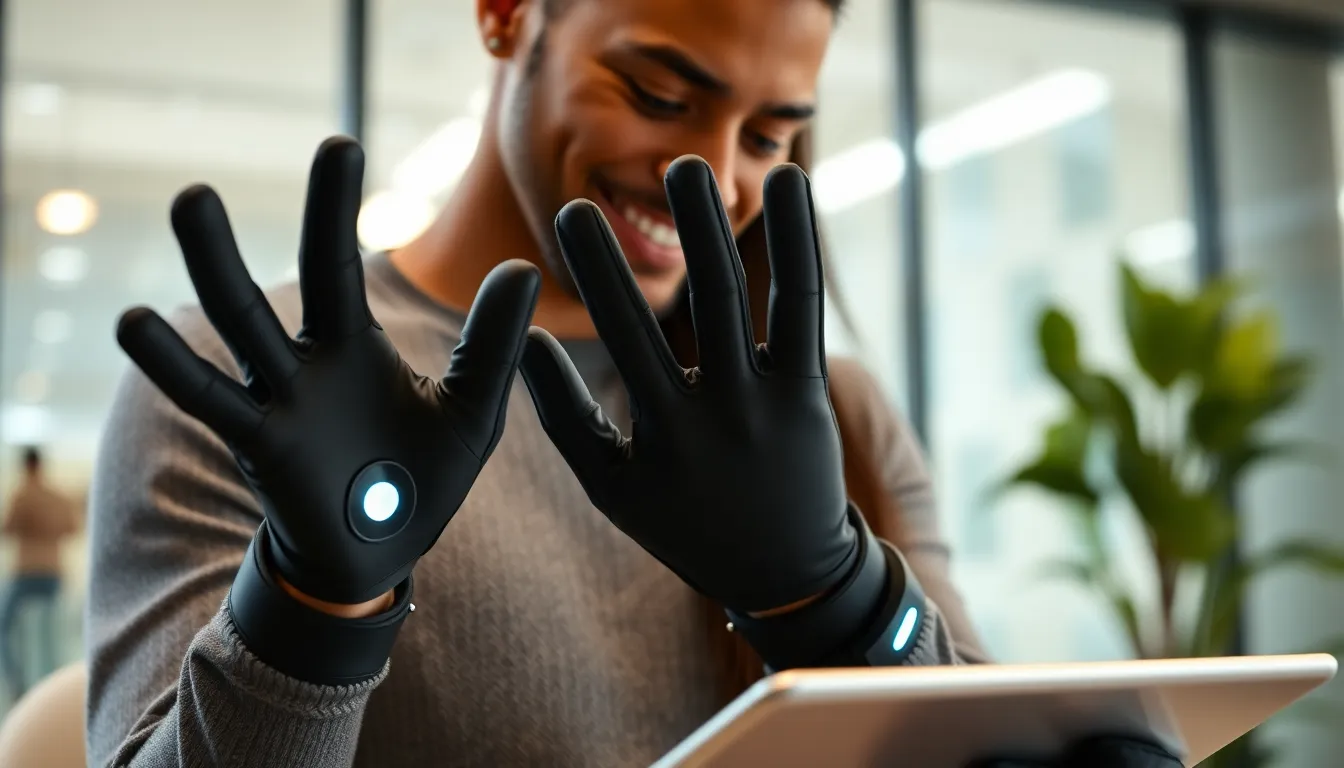Imagine typing away on your laptop while strolling through the park, or sending a quick email during a meeting without the awkwardness of a traditional keyboard. Enter the wearable keyboard—a gadget that’s not just cool but also a game changer in how we interact with technology. It’s like having a personal assistant strapped to your wrist, ready to help you conquer the digital world without missing a beat.
These innovative devices blend convenience with creativity, making typing as easy as a flick of the wrist. Whether you’re a busy professional or a tech enthusiast, the wearable keyboard offers a hands-free experience that’s bound to impress. Say goodbye to cramped fingers and hello to the future of typing, where freedom and functionality meet in perfect harmony.
Table of Contents
ToggleOverview of Wearable Keyboards
Wearable keyboards are innovative devices that enhance how users interact with technology on the go. They provide convenience by allowing typing during various activities, such as walking or attending meetings. Designed for flexibility, these keyboards easily connect to smartphones, tablets, or laptops via Bluetooth.
These devices come in various forms, including wristbands, gloves, and even wearable projectors. Users can choose options that best suit their needs, whether for professional tasks or casual communication. Built with portable materials, wearable keyboards are lightweight and easy to carry.
Ergonomics plays a critical role in wearable keyboard design. They minimize strain during typing sessions by encouraging natural hand positions. With adaptive layouts, users can personalize their typing experience, enhancing productivity.
Battery life varies among models, with some lasting up to 40 hours on a single charge. This strength ensures users can rely on their devices throughout the day without frequent recharging interruptions. Additionally, compatibility with different operating systems broadens their usability.
Integrating features like voice recognition enhances functionality. Wearable keyboards support voice commands, complementing traditional typing for improved multitasking. Users benefit from increased flexibility, adapting their input method to specific situations.
Overall, wearable keyboards cater to dynamic lifestyles. Whether for professionals needing efficiency or casual users seeking convenience, these devices provide innovative solutions for modern computing challenges.
Types of Wearable Keyboards

Wearable keyboards come in various forms, each designed to meet specific user needs.
Smart Gloves
Smart gloves integrate technology with traditional typing. These gloves often feature sensors that track hand movements, translating gestures into text. Users can easily send messages or control devices without needing a physical keyboard. They work seamlessly with smartphones and tablets. Many modern models are touch-sensitive and compatible with voice recognition, enhancing their versatility. Convenience in typing comes from their design, which ensures a snug fit and comfort. Some smart gloves even include haptic feedback, providing tactile responses to users.
Flexible Keyboards
Flexible keyboards are another innovative option in the wearable keyboard category. Made from silicone, these keyboards can roll up for easy transport, making them ideal for on-the-go professionals. They connect via Bluetooth, allowing for a clutter-free workspace. Users benefit from their water-resistant designs, ensuring durability in various environments. Furthermore, lightweight and portable, flexible keyboards cater to different typing styles and ergonomic preferences. Many versions also feature backlighting, offering visibility in low-light conditions.
Advantages of Wearable Keyboards
Wearable keyboards offer significant benefits that cater to the needs of modern users. These devices enhance overall interaction with technology, making typing more accessible in various situations.
Portability and Convenience
Portability defines wearable keyboards. Their lightweight designs allow users to carry them easily in pockets or bags. Users can type on-the-go, whether commuting, traveling, or during outdoor activities. Often, these keyboards don’t require a flat surface, enabling typing while standing or walking. Convenience increases as users connect with multiple devices through Bluetooth. They can switch between smartphones, tablets, and laptops effortlessly without losing productivity. Functional designs enhance usability, allowing users to type anywhere without the constraints of traditional keyboards.
Enhanced Productivity
Wearable keyboards significantly improve productivity among users. These devices support multitasking by allowing hands-free operation when combined with voice recognition technology. Typing speeds increase due to ergonomic layouts that reduce strain during long sessions. Users can maintain comfort while working on extensive projects or communication tasks. Customizable features enable tailoring the keyboard’s settings for individual preferences, boosting efficiency further. Swift access to notifications and messages without retrieving devices enhances workflow. Overall, wearable keyboards streamline processes, making them a valuable tool for busy professionals and tech enthusiasts alike.
Potential Applications
Wearable keyboards present diverse applications across various fields. These innovative devices enhance user interaction in different scenarios.
Gaming and Entertainment
In gaming, wearable keyboards offer a unique advantage. Gamers can enjoy immersive experiences without being restricted by traditional setups. Devices like smart gloves allow for gesture-based controls, providing seamless input in virtual environments. Enhanced responsiveness and comfort contribute to longer play sessions without fatigue. Bluetooth connectivity enables easy pairing with gaming consoles or PCs, making them versatile options for gaming enthusiasts. The integration of customizable macros allows players to optimize their gameplay experience, ensuring quick access to commands. Wearable keyboards elevate the entertainment experience by blending physical interaction with digital worlds.
Assistive Technology
Wearable keyboards serve significant roles in assistive technology. Users with disabilities benefit from hands-free typing options, promoting independence. Smart gloves can translate hand movements into text, facilitating better communication for those with limited mobility. The incorporation of voice recognition enhances functionality, allowing users to control devices effortlessly. Ergonomically designed wearable keyboards minimize strain, ensuring comfort for longer usage periods. Additionally, intuitive layouts can adapt to varying abilities, catering to individual needs. This adaptability fosters inclusivity, making technology more accessible for everyone. Wearable keyboards are crucial tools for empowering users in both personal and professional settings.
Challenges and Limitations
Wearable keyboards face several challenges that impact their widespread adoption. Ergonomic issues arise from varied user preferences and comfort levels, which can hinder the typing experience. Some users may find the small size of these devices awkward, leading to discomfort during prolonged use.
Battery limitations pose another significant hurdle. Although many models boast impressive battery life, the need for regular charging still exists. Users often appreciate longer battery life for extended sessions but may struggle with devices that require frequent recharging.
Connectivity complications can also disrupt user experience. While Bluetooth compatibility is widely available, signal interference or connectivity drops can frustrate users. Certain environments with many electronic devices might exacerbate this problem, limiting effectiveness in crowded settings.
Certain wearable keyboards lack versatility in their operating system compatibility. Some models only work with specific platforms, reducing potential user base. This limitation can prevent users from integrating these devices into their preferred workflows seamlessly.
The learning curve presents an additional drawback. Adapting to the unique layouts of wearable keyboards may take time, especially for those accustomed to traditional keyboards. Users seeking efficiency may initially encounter delays until they become proficient.
Durability concerns remain valid as well. Many wearable keyboards are constructed from lightweight materials, which can lead to wear and tear over time. Users weighing longevity against portability may find this trade-off challenging.
Finally, limited customization options can hinder user satisfaction. While some keyboards offer customizable features, others do not support extensive modifications, decreasing their appeal. Users often appreciate tailored settings that enhance their typing experience, yet not all models deliver this functionality.
Wearable keyboards are set to change the way people interact with technology. Their convenience and innovative designs cater to a variety of users, from busy professionals to gamers. With features like ergonomic layouts and seamless connectivity, these devices enhance productivity and comfort.
Despite some challenges like battery life and compatibility issues, the potential applications across different fields highlight their versatility. As technology continues to evolve, wearable keyboards may become essential tools for anyone looking to improve their typing experience on the go. Embracing these advancements could lead to a more efficient and enjoyable way of engaging with digital devices.






